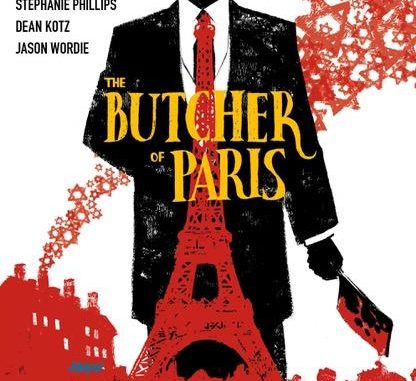
Review Fix talks with comic writer Stephanie Phillips on her current comic mini-series, THE BUTCHER OF PARIS, on the monstrosity of eponymous serial killer, Marcel Petiot, what horrors of anti-Semitism can lead to and her upcoming series for Aftershock Comics, ARTEMIS AND THE ASSASSIN.
Review Fix: You mentioned in the epilogue of the first issue, you were doing research based on the Nazi occupation of France, when you came across Marcel Petiot, the eponym Butcher of Paris. What compelled you to write the story?
Stephanie Phillips: The story of Marcel Petiot stuck with me. I have always been interested in history and this story gave me a unique opportunity to show a side of WWII that I don’t think is very common. It’s a serial killer in Nazi-occupied Paris hunted by the Gestapo and the French police… it’s one of those stories that’s so crazy it could only be true.
Review Fix: What research did you do to write this story, also how was the research and creative process like?
Phillips: There are only a few, mostly academic, books about Petiot out there, but I read everything that even mentioned his name. I also learned a lot about Paris during WWII to better understand the period when the city under the occupied rule. Finding specific information about some of the other characters, like Detective Massu, was a little more challenging. This information primarily came from newspaper articles about any case that mentioned Massu. The hardest part was understanding that I had five issues of the comic and hundreds of pages worth of research. I wanted to strike a balance between the story and the history, and not lose track of the actual story – the people involved – while including historical fact.
Review Fix: The story is set during and inspired by past events during World War II, however it feels that it is a reflection of the current rise of anti-Semitic attacks, would you say so?
Phillips: Yes, I see a lot of modern-day connections to a story that primarily discusses complicity and empathy. In college, I had the opportunity to meet Elie Wiesel, a Holocaust survivor and the author of Night. Until his death, Wiesel was an educator hoping to help a younger generation connect to history on a personal level and, hopefully, not repeat the mistakes of the past. Wiesel once said, “We must take sides. Neutrality helps the oppressor, never the victim. Silence encourages the tormentor, never the tormented.†I hope that The Butcher of Paris asks the reader to consider the themes of silence, empathy, and complicity and how we can apply those to modern-day rhetoric concerning fascism, Nazism, and hate speech of any kind.
Review Fix: The Butcher of Paris is a historical crime-drama, with that said, in Issue#2, Detective and Commissaire Georges-Victor Massu pick a devil mask and sees one of the victims of Petiot being tortured. Is there a supernatural element to the story and what is the significance to that scene?
Phillips: No supernatural element. Massu’s mind is working overtime and we get a glimpse of what Massu is picturing here. Massu knows that something terrible happened in this room, and his mind is speculating in gruesome detail. Sometimes, nothing is as worst as our own imaginations.
Review Fix: What do you want the audience to get from reading this story?
Phillips: That Dean Kotz, Jason Wordie, and Troy Peteri are a fantastic team and should be working on more books together!
Apart from that, I can only speak to my intention of writing about empathy and complicity. This was a difficult time and I hope some of the nuances of the relationships taking place in Nazi-occupied Paris come through in the story.
Review Fix: Maya, a skilled assassin from the future is sent to kill Virginia Hall (codename Artemis), a famed World War II Allied spy, though unexpected developments happen in which their lives are forever alter. How did you come with the story of ‘Artemis and the Assassin’?
Phillips: I like writing about things that are out of place and about history, so sending an assassin through time to cooperate with a WWII spy hits all the buttons for me. While taking a lot of inspiration from history, there are also a lot of elements from different mythologies embedded throughout the story.
Review Fix: It appears that both women have been “pitched headlong through timeâ€, without spoilers, where or rather when are Maya and Artemis going to?
Phillips: Part of the fun of a time travel story is allowing your characters to interact with unexpected places. Without giving too much away, the story plays with the Wild West, ancient Egypt, WWII, and more.
Review Fix: What is it like working with artists Meghan Hetrick and Francesca Fantini, to bring this story to life?
Phillips: Meghan and Francesca are both extremely talented artists. Both have these unique abilities to render the most life-like facial expressions that I think add so much to Maya and Virginia throughout the book. At times, I just wanted to remove all dialogue and let the expressions and body language of the characters speak for the entire page. It’s fascinating to watch Meghan and Francesca bring the story to life on the page.


Leave a Reply